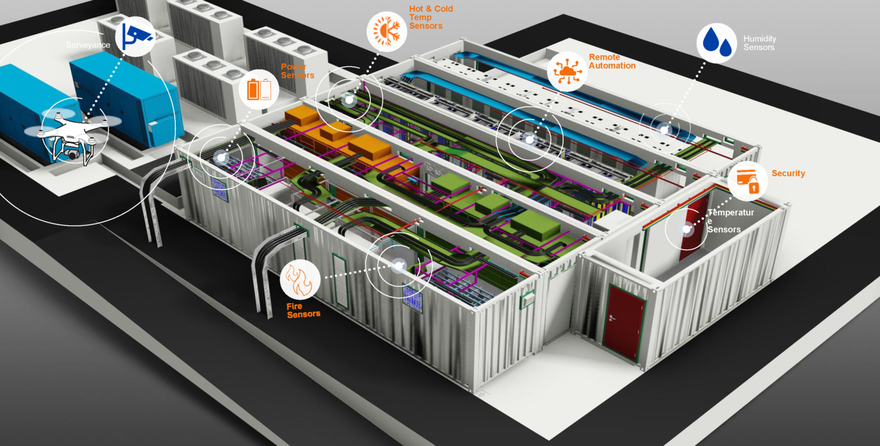One of the more intriguing and beneficial use cases for hyperscale and 5G is the data center itself. More specifically, the IoT and artificial intelligence (AI), backed by the power of hyperscale computing, have become important tools for enabling lights out (unmanned) data center operation.
Hyperscale computing demands are ratcheting the pressure on operators to become leaner, greener, and faster.
The data-center-as-use-case concept is a bit like using regenerative braking to recharge electric car batteries. Harnessing of hyperscale outputs like 5G and the IoT to improve efficiency is a win-win for hyperscalers, developers, and customers.
Monitoring at the Edge
Edge computing plays a pivotal role in bringing applications closer to the user to meet the connectivity and latency requirements of the IoT.
Exponential growth in Edge deployments along with constraints on size and power consumption in hard-to-reach locations have made Edge data centers the unwitting pioneers of “lights out” operation. At the same time, shifting applications and intelligence are blurring the lines between cloud and Edge.
If unmanned operation works at the Edge, does it also work for hyperscale data centers?
The challenges of unmanned hyperscale
Although sensing and monitoring technology for the Edge is similar, the approach must scale to meet the outsized hyperscale requirements.
Unmanned operation takes on proportions for hyperscale data centers that are consistent with the 10,000 square foot minimum footprint defined by the IDC (many data centers now exceed one million square feet).
The quantity of hardware, varied environmental conditions within the facility, and high data concentration make unmanned operation challenging. Hyperscale data center aisle width, server rack height, and supporting infrastructure have all been designed with humans in mind.
As the architecture adapts to an unmanned state, other large-scale industrial internet of things (IIoT) applications like factory automation and connected health lay down a blueprint for effective monitoring and feedback.
In each case, the artificial intelligence and big data storage features of the hyperscale data center are essential.
Unmanned data center features
Temperature sensing
Air and equipment temperatures are critical indicators of data center performance. Hyperscalers striving for cooling efficiency often straddle the upper operating limits.
One degree (or less) over the limit can lead to equipment failure while lower temperatures can undermine cooling expenses. The ultra-low latency and connection density of 5G IoT combined with the intelligence of hyperscale computing redefines temperature monitoring.
Rather than alerting human operators when conditions change, real-time data and analytics feed into continually optimized temperature profiles. Humidity, vibration, and pressure sensors add to the treasure trove of data interpreted and stored through hyperscale computing.
Fire protection
High energy density, static electricity, and abundant flammable materials make hyperscale data centers vulnerable to fire hazards. National Fire Protection Association (NFPA) standards and codes are intended to protect equipment, facilities, and workers.
Like many other industries, data centers have long relied on smoke detectors, fire extinguishers, and sprinklers. With the financial implications of downtime or lost data, reactive methods no longer suffice.
Real-time IoT sensing and analysis of electrical and environmental conditions can be used to proactively identify dangerous states. If smoke or flames are detected, 3D positioning localizes fire suppression to minimize hardware damage.
Remote automation
Remote data center monitoring and automation have progressed in parallel as the hyperscale ecosystem has evolved. The two paths have merged on the road to unmanned operation, with real-time data feeding the built-in artificial intelligence of the data center.
Rather than continually monitoring for situations where human intervention is called for, AI leapfrogs alerts to implement autonomous solutions. Remote monitoring and automation also provide better visibility for customers, with unlimited real-time and historical data leading to more actionable insights.
Power monitoring
Remote power monitoring benefits operators and the environment. Intelligent power distribution units (iPDUs) are a leading option for lights out hyperscale.
Per-outlet power sensing provides real-time data at the individual device level to optimize power settings. When remote power monitoring is fortified by hyperscale predictive intelligence, component failures are anticipated and technician time on site is minimized.
Stranded capacity and other sources of waste are identified and corrected immediately so that overall power consumption is reduced.
Security
Data security and physical security are important considerations for unmanned data centers. Physical security improves by default with less frequent facility visits. Biometric authentication tools like facial recognition are effective barriers to physical access.
An added layer of 24/7 physical security can be afforded by IoT surveillance drones or robots. Rather than relying on redundant infrastructure and encryption to safeguard data security, threat intelligence tactics leverage enriched flow records and packet data to proactively detect indicators of compromise (IOC). Real-time threat maps and dashboards compliment the unmanned data center operation.
Unmanned hyperscale benefits
Unmanned data centers once seemed like the stuff of science fiction. Today, with environmental challenges and 5G disaggregation driving leaner options, the future of hyperscale is lights out.
Apart from the convenience of autonomous operation, each contributing element also improves efficiency. This includes optimized power, cooling, and security based on real-time adjustment and the removal of geographic constraints.
With human presence no longer mandatory, data centers can be located in cooler albeit less hospitable climates, or even under water.
As we have learned from past industrial revolutions, removing humans from the data center does not reduce their value. IT and computer science professionals will be free to pursue more proactive tasks including advanced threat hunting, capacity planning, and algorithm refinement.
The development of automated data center test solutions and advanced monitoring software are additional challenges that require top shelf computer talent and experience.
With a long history of innovation and participation in every major technology shift, VIAVI has developed the test portfolio and expertise needed to enable the next generation of hyperscale computing.
Automated test and monitoring tools for fiber certification, high speed transport, 5G RAN validation, and remote network observability ensure success and customer satisfaction throughout the network lifecycle.
More from VIAVI
-

Sponsored Hyperscale use case: Advanced Driver-Assistance Systems (ADAS)
Could Advanced Driver-Assistance Systems (ADAS) be the push needed toward a fully autonomous future?
-

Sponsored Hyperscale ecosystems: Factory automation and the industrial IoT
Viavi CTO Sameh Yamany examines the elements behind the industrial IoT and how hyperscale data center ecosystems will support it
-

Sponsored Managing the pain points of the hyperscale ecosystem
A larger ecosystem brings with it the potential for larger problems




